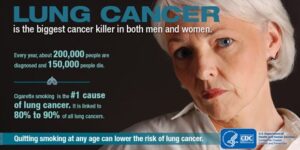November is Chronic Obstructive Pulmonary Disease (COPD) and Lung Cancer Awareness Month Awareness Month. Both diseases can affect anyone. However, smoking is a primary cause of each. This is why it is particularly important for those who smoke to quit smoking, and to avoid environments where people are exposed to secondhand smoke.
Part 1 touched on COPD. This post will talk about lung cancer. Let’s take a moment to learn about it.
Lung cancer is when cells multiply uncontrollably in the lungs. Symptoms don’t normally appear until the cancer cells spread to other parts of the body and prevent other organs from functioning properly. At that point, it is harder to treat lung cancer. Smoking poses the greatest risk for lung cancer. However, other factors like radon and air pollution can contribute. 1
Similar to COPD, smoking causes about 90% of lung cancer cases. Many chemicals in tobacco smoke are known to cause lung cancer.
Other risk factors include:
- Secondhand smoke exposure
- Former smoker (you’ll decrease your risk if you quit, but it isn’t eliminated)
- Radon exposure
- Radon is the second leading cause of lung cancer
- It is a colorless, odorless radioactive gas that exists naturally in soil
- Be on the lookout for a blog post in January which is National Radon Action Month!
Symptoms include:
- A cough that doesn’t go away and gets worse over time
- Hoarseness
- Constant chest pain
- Shortness of breath or wheezing
- Frequent lung infections or wheezing
- Cough up blood
Some symptoms may not appear until the cancer has spread to other parts of the body. These symptoms may not be present in earlier stages of lung cancer. They include:
- Weight loss
- Loss of appetite
- Headaches
- Bone pain or fractures
- Blood clots
If you’re experiencing any of these symptoms, please consult with your medical provider. Early detection increases your chance of surviving for five years or more. You can also check out this eligibility tool offered by Saved by the Scan to see if you should be screened for lung cancer.


Lung cancer is the leading cancer killer for both men and women in the U.S.1 In Alaska, the number of new lung cancer cases is about the same as the national average. However, Alaska is ranked 39th out of 45 for 5-year survival rate. (Five states don’t have this measure). Alaska is ranked 47th out of 49 states for early diagnosis. Indigenous Peoples in Alaska are most likely to be diagnosed with lung cancer. There isn’t state level 5-year survival for the Indigenous population at this time. Nationally, the five-year survival rate for Indigenous People is lower than white Americans 3
Check out the newly released 2021 State of Lung Cancer Report here for more information. Please visit the Saved by the Scan webpage to see if you should be screened to lung cancer.
- Lung Cancer Basics | American Lung Association
- Lung Cancer Symptoms | American Lung Association
- State Data | Alaska | American Lung Association
- Image Source: Lung Cancer Is the Biggest Cancer Killer in Both Men and Women | CDC



